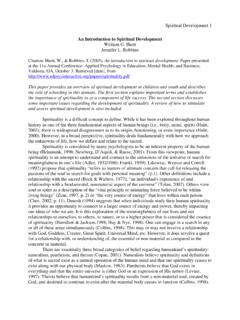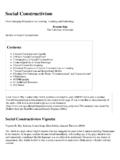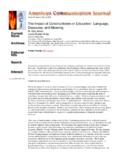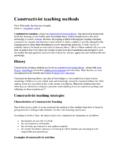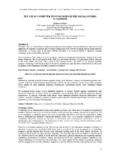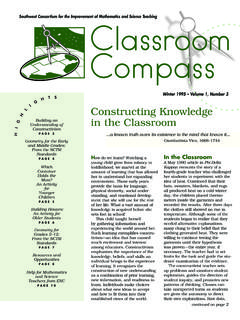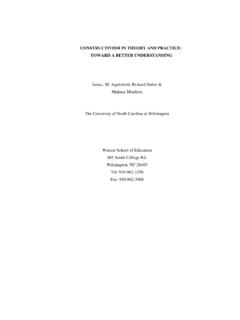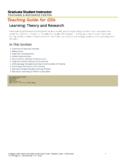Transcription of Connecting Cognitive Development and …
1 Cognitive Development 1. Connecting Cognitive Development and constructivism : Implications from Theory for Instruction and Assessment Stacey T. Lutz William G. Huitt Citation: Lutz, S., & Huitt, W. (2004). Connecting Cognitive Development and constructivism : Implications from theory for instruction and assessment. constructivism in the Human Sciences,9(1), 67-90. Retrieved [date] from This paper provides an overview of the developmental theories of Dewey, Piaget, Vygotsky, and Bruner that provide the basis for the educational application of constructivism .
2 Activities for developing instruction and assessment built on constructivistic theories are also discussed. A review of the last fifteen years of literature reveals the attempt to consolidate the findings of a number of Cognitive psychologists and philosophers who contend that several major assumptions of the information processing approach to cognition are incomplete. For example, one of the assumptions of this approach is that knowledge and competencies of thinking are situated within the individual and can be studied independently of the situation within which they are used (Bruner, 1990).
3 Alternatively, Greeno (1989), a leading proponent of situated learning, proposes that thinking is a result of interaction between the individual and the environment. Greeno argues that person/environment interactions are of such a complexity as to make attempts to discover generalized Cognitive processes quite irrelevant. Rather he suggests a need to study how a student's innate abilities are used to develop knowledge and thinking competencies through interaction with specific environments. This position suggests that the information processing model may be adequate to explain current understandings of how memory operates, but it does not fully describe or predict differences in Cognitive Development .
4 Situated models like Greeno's serve to highlight an ecological model for Cognitive Development that focuses on how individuals construct meaning from interactions with their environments (Huitt, 2003). As in every domain of human Development , there are three major questions that are addressed: what is the role of biology, what is the role of experience, and how can the environment be arranged so as to best address the interaction between these two factors? John Dewey, Jean Piaget, Lev Vygotsky, and Jerome Bruner, researchers who provide the theoretical underpinnings for the increasingly popular constructivistic approach to the teaching/learning process, have different responses to these questions.
5 However, the group of theorists discussed in this paper would subscribe to this questioning of assumptions. While they may disagree as to the emphasis on the individual or environment, they would all recognize the importance of studying person/environment interactions. This acknowledgment increases the complexity of their findings, making them that much more difficult to understand and use in guiding and assessing students' Cognitive Development . Consequently, there are many questions that remain unanswered. This paper will provide an overview to theories that provide a theoretical underpinning to the constructivistic approach, as well as practical suggestions for classroom practice and methods of assessment and evaluation germane to the constructivistic approach.
6 Cognitive Development 2. John Dewey John Dewey (1998) was an American psychologist and philosopher who promoted the value of personal experience in learning. He placed relatively little emphasis on maturational factors and taught that human beings understand the world through interaction with their environment and, thus, knowledge is constructed by the individual. Dewey (1944) proposed that a primary function of schooling was to prepare young people to live in a democratic society and that one's reflection on personal experiences would provide the foundation for the Development of the necessary attributes for successful living.
7 He believed the dualistic conceptualization of thinking and doing to be false. Rather he proposed a reciprocal, continuous relationship between thinking and doing that is reflected in the work of the other researchers discussed in this paper (Vanderstraeten & Biesta, 1998). As a leader in the progressive education movement in the early 20th century, his work set the stage for an acceptance of the work of later researchers. Jean Piaget Jean Piaget (2001) was a Swiss biologist, philosopher, and behavioral scientist who developed one of the most significant theories in Cognitive psychology.
8 His stage theory gained wide acceptance in the 1960s and 1970s as a result of the translations of his work into English and its promotion by influential American psychologists ( , Flavell, 1963). His impact on the field of Cognitive Development cannot be overstated, even though many of the precepts he developed have been criticized by subsequent evidence (Parent, Normandeau & Larivee, 2000). Piaget described himself as a genetic epistemologist. His work focused on developing a general theory of knowledge, how a child develops a knowledge of his or her world, and the role that biology plays in that Development .
9 To Piaget, intelligence is represented by how an organism interacts with its environment through mental adaptation. This adaptation is controlled through mental organizations or structures that an individual uses to represent the world; it is driven by a biological impulse to obtain balance (homeostasis or equilibrium) between those mental organizations and the environment. Piagetian theory can be discussed in two parts: 1) his theory of adaptation and the process of using Cognitive schemes and 2) his theory of Cognitive developmental stages (Huitt and Hummel, 1998).
10 The process of coming to know, the first aspect of Piaget's (2001) theory, starts with the fact that individuals are born with reflexes that allow them to interact with the environment. These reflexes are quickly replaced by constructed mental schemes or structures that allow them to interact with, and adapt to, the environment. This adaptation occurs in two different ways (through the processes of assimilation and accommodation) and is a critical element of modern constructivism . Adaptation is predicated on the belief that the building of knowledge is a continuous activity of self-construction; as a person interacts with the environment, knowledge is invented and manipulated into Cognitive structures.
